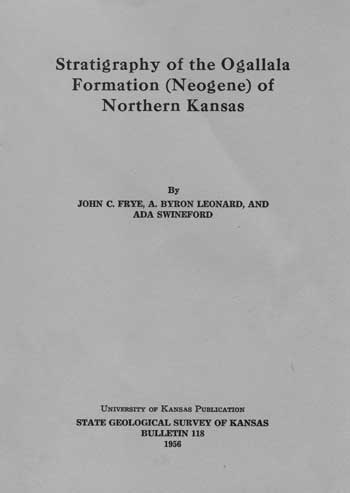Stratigraphy of the Ogallala Formation (Neogene) of Northern Kansas
by John C. Frye, A. Byron Leonard, and Ada Swineford

Originally published in 1956 as Kansas Geological Survey Bulletin 118. This is, in general, the original text as published. The information has not been updated.
Abstract
Fluvial late Tertiary (Neogene) deposits underlie the surface of the dissected plateau that is the High Plains, and extend from Texas to South Dakota in a belt several hundred miles wide. The stratigraphy and paleontology of the Neogene Ogallala formation have been studied in northern Kansas and correlations made with type sections of the Ogallala formation, and Valentine, Ash Hollow, and Kimball members in Nebraska. Ogallala sediments were deposited by streams flowing eastward from the Rocky Mountain region in broad, relatively shallow, erosional valleys cut in Cretaceous bedrock. Initial alluviation of these valleys is represented by the Valentine member. As alluviation proceeded, sediments progressively overlapped gentle valley slopes, and minor divides were buried by sediments of the Ash Hollow member. The Kimball member transgressed most major divides, producing a coalescent alluvial plain. This surface is marked by an accumulation of calcium carbonate. The Ogallala contains fossil vertebrates, mollusks, and seeds. Fossil vertebrates, although having time significance, are of little local stratigraphic value. Molluscan faunas show an orderly progressive change bridging the interval from late Miocene (?) to earliest Pleistocene, and present distinctive assemblages in Valentine, Ash Hollow, and Kimball members. Abundant and widely dispersed fossil seeds are the most usable organic remains for regional stratigraphic work. Ten petrographically distinct volcanic ash falls occur in the Ogallala; seven have proved valuable in precise correlations throughout the region and with type localities in Nebraska.
Lithologically, the Ogallala formation is heterogeneous, but each member presents certain gross characters distinguishing it from the others. The Valentine member is predominantly gray to greenish-gray feldspathic sand, only loosely cemented with calcium carbonate; it includes some clay and silt and local opal-cemented sandstone lenses. The Ash Hollow member is typified by gray to brown, feldspathic sand, silt, and gravel having irregular calcareous cementation; soft limestone; and numerous lentils of volcanic ash. The Kimball member, although containing local lentils of coarse gravel in the base, is predominantly calcareous feldspathic sandy silt capped by a massive to nodular sandy and silty calcium carbonate zone.
Kansas Geological Survey, Geology
Placed on web Aug. 4, 2011; originally published March 1956.
Comments to webadmin@kgs.ku.edu
The URL for this page is http://www.kgs.ku.edu/Publications/Bulletins/118/index.html